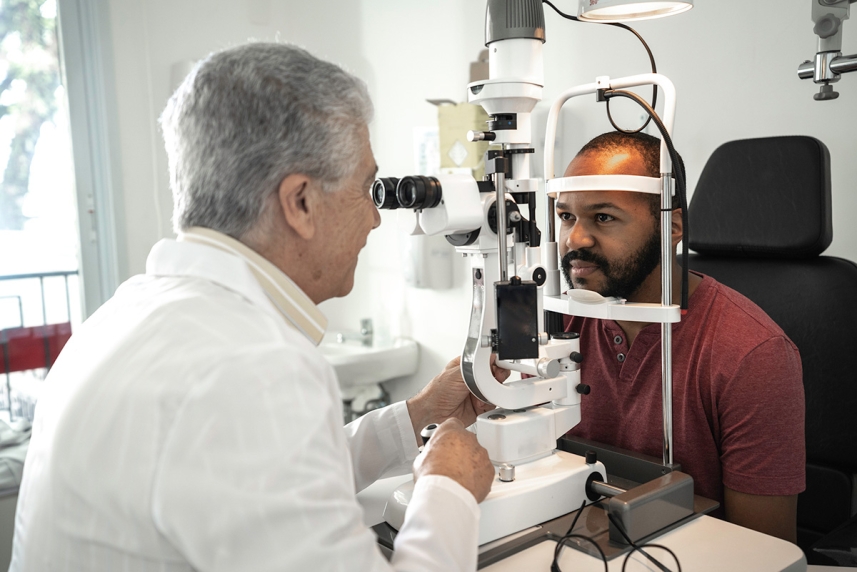7 early warning signs for inherited retinal diseases (IRDs)
This group of conditions can cause vision loss over time. Learning the early signs can help with faster care and better treatment options.

Inherited retinal diseases (IRDs) are a group of genetic conditions that affect the retina—the part of the eye that senses light. These conditions can lead to vision loss over time. Each IRD is caused by at least one gene that doesn’t work the way it should.1
Some people know that eye diseases run in their family. Others may not have any idea. But even without a family history, there are still signs that could point to an IRD. Knowing what to look for early can help lead to faster diagnoses and better care.1
Here are 7 early warning signs that could mean it’s time to see an eye care provider.
1. Night blindness
Having trouble seeing in low light is often one of the first signs of some inherited retinal diseases. This is sometimes called “night blindness.” It may become hard to adjust when moving from bright spaces into darker ones, like walking into a dim room or driving at night.3,4
This is an early symptom of conditions like retinitis pigmentosa and choroideremia—two types of IRD.1
2. Tunnel vision
Some people with IRDs lose side vision first. This is called “tunnel vision,” and it means only the center of the vision stays clear.5 It can feel like looking through a narrow tube. Bumping into things or having trouble noticing what’s off to the side might be early signs.
Tunnel vision can show up as a condition like retinitis pigmentosa gets worse, or as choroideremia progresses.1
3. Poor vision in childhood
For some IRDs, signs can begin very early—sometimes even in childhood. A child may squint a lot, rub their eyes or seem clumsy because they’re not seeing clearly. In boys especially, early details may point to choroideremia.4
Children may not be able to describe their symptoms, so noticing these small behavior changes is important.
Stay on top of eye health with an in-network eye care provider. Search now.
4. Loss of detail or focus
A person with an IRD may have trouble seeing fine details. This can make reading, recognizing faces or seeing signs harder. In the beginning, the brain may “fill in” the missing parts, making changes harder to notice right away. But over time, these problems can affect everyday tasks.
5. Difficulty seeing in bright light
While some people struggle with low light, others may be more sensitive to bright light. This can be a sign of damage in certain parts of the retina. In some IRDs, the cells that help control brightness stop working well, leading to discomfort or washed-out vision in sunlight.2
Wearing sunglasses may help, but light sensitivity can still be a sign that something more serious is going on.
6. Blind spots that come and go
Seeing “missing” spots or blank patches in vision can be a warning sign. These blind spots may come and go at first. As an IRD gets worse, the blind spots can become larger or more noticeable.
Some people may not realize they have blind spots until they start to affect reading, driving or navigating busy places.
Providers in the UnitedHealthcare Vision Network are available to help diagnose and treat the most complex vision-related issues. Search for an eye care provider now.
7. Family history of vision problems
Even if someone doesn’t have symptoms yet, having family members with vision loss may be a sign that an IRD could be present. A parent, grandparent or sibling with night blindness, tunnel vision or unexplained vision loss could point to an IRD that runs in the family.
Still, it’s important to know that a person can have an IRD without any known family history. That’s why regular eye exams are key.
How IRDs are diagnosed
Diagnosing an IRD usually starts with a detailed eye exam by an optometrist or an ophthalmologist. This may include a dilated eye exam, where drops are used to widen the pupils and allow a clear view of the retina.5 The provider may also use imaging tests to take pictures of the inside of the eyes.5
Genetic testing may also be offered.5 A simple blood or saliva sample can help find out if certain genes are linked to the symptoms. Even if a treatment isn’t available yet, getting a diagnosis can help guide next steps and connect patients to the latest research.
Sources:
- Night Blindness (Nyctalopia). Cleveland Clinic, December 19, 2023
- Retinitis Pigmentosa. National Eye Institute, November 15, 2023
- Choroideremia. Choroideremia Research Foundation
- Glossary of Eye Conditions. American Foundation for the Blind
- What Are Inherited Retinal Diseases (IRDs)? PreventBlindness.org


